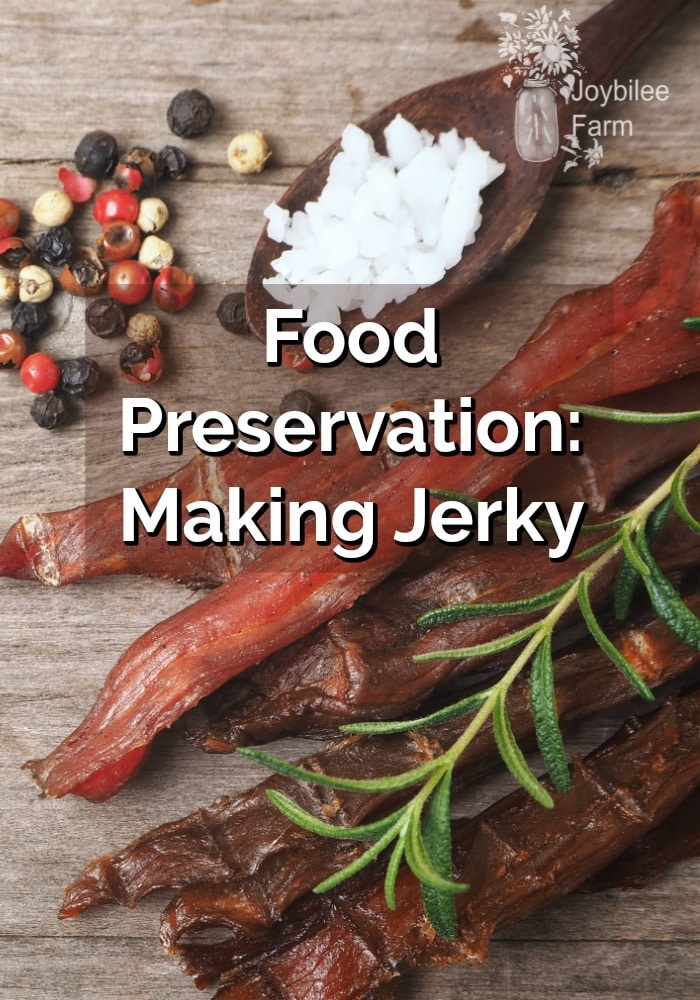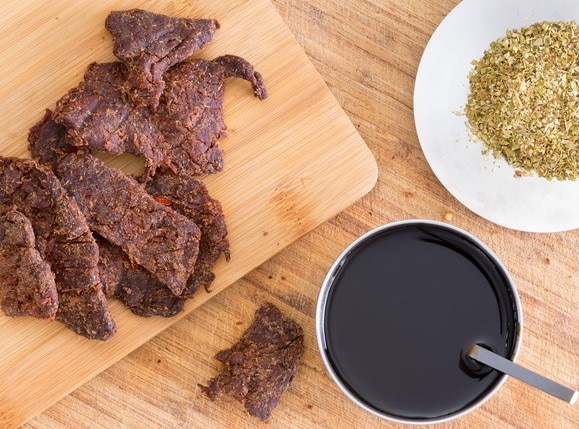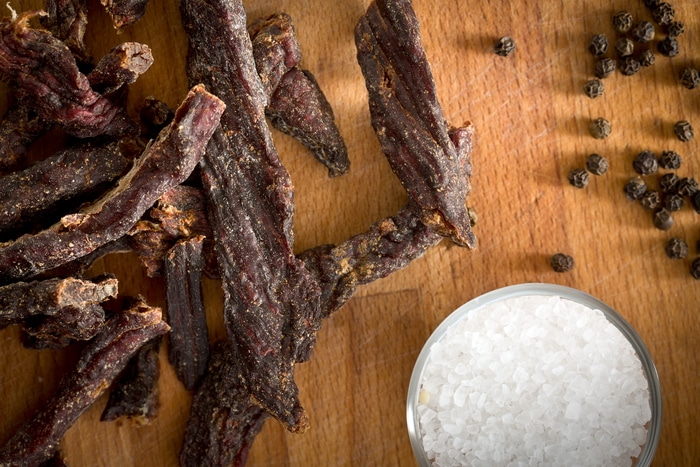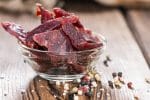Making jerky at home you know what’s in it. You can avoid the sodium nitrate and other carcinogens. You control the spices, the amount of salt, and the flavors as well. You home made jerky is healthier and tastes fresher than commercial beef jerky.
Whether you are hunting or raising your own meat, sometimes you don’t want to preserve it in the freezer. One alternative is to make jerky. Jerky is basically spiced, marinated and dried fresh meat. Jerky is raw meat or fish, that’s full of healthy natural enzymes and protein. You don’t cook the meat before you dehydrate it.
Wild game, beef, mutton, goat, salmon, and poultry are all candidates for healthy, flavorful jerky.
Jerky keeps indefinitely. High in protein, natural enzymes. and convenience, its great for camping, hiking and lunch on the go. Jerky uses less expensive, tougher cuts of meat. The marinade and the slow drying tenderizes the meat.
Store bought jerky is high in sodium nitrate, a known carcinogenic. When you make your own, you control the ingredients and ensure a quality product.

Sterilize your cutting board, knives and counter top with a vinegar solution followed by a hydrogen peroxide solution before you begin. Since jerky is raw meat you’ll want to minimize microbe contamination.
Now your ready to make jerky
Debone the meat. Remove excess fat. Slice your meat into 1/4 inch strips. Place in a casserole dish or deep bowl. Cover with marinade.

Recipe: Marinade
4 garlic cloves, crushed
1 cup of wine, beer or soy sauce
2 tsp. sea salt (omit if you are using soy sauce)
1 cup cider vinegar or lemon juice
1/4 c. Worcestershire sauce
1/4 c. brown sugar
1/4 tsp. pepper
1 tsp. dry mustard
1 tbsp. liquid smoke
1/2 tsp. ground chili (optional)
2 tsp. spices (oregano, mint, basil, tarragon, thyme, sage, tumeric, cumin, chives, parsley, etc) Alternate spices for different batches to achieve variety in flavors.
Change the ingredients and add spices and salt to your taste
Pour marinade over meat in deep bowl or casserole. Cover with a plate or plastic wrap. Refrigerate overnight or at least 4 hours.
Lay out on dehydrator trays in a single layer. Dry at 155 degrees F. for 6 to 8 hours, turning after 3 hours. Move dehydrator trays as necessary to ensure even drying. Continue drying until meat is dry and crisp, with no moist or soft spots.
Drying jerky in the oven
If you don’t have a dehydrator, you can dry jerky in your oven. Lay the meat on baking sheets. Put the oven temperature at the lowest setting (150F in my oven), turn on the oven light, and keep the oven door propped open for ventilation. Turn meat after 3 hours and again after 6 hours. Leave over night. This uses a lot of electricity. If you will be doing a lot of drying, consider investing in a dehydrator.
Allow the jerky to cool completely before storage. Store in a covered jar, in a cool, dry place. Eat as is, or reconstitute in water before cooking. Make up vegetable soup base by mixing jerky, and dried vegetables together with spices for self sufficient convenience food. Jerky is great for hiking, camping or for lunch on the go. Add some to your bug-out bag for a high protein meal.


Jerky
- Prep Time: 60 min
- Cook Time: n/a
- Total Time: 60 min
Description
Preserve extra meat by making homemade jerky, works with beef, goat, sheep, and wild game.
Ingredients
- 1kg+ meat
- 4 garlic cloves, crushed
- 1 cup of wine, beer or soy sauce
- 2 tsp. sea salt (omit if you are using soy sauce)
- 1 cup cider vinegar or lemon juice
- 1/4 c. Worcestershire sauce
- 1/4 c. brown sugar
- 1/4 tsp. pepper
- 1 tsp. dry mustard
- 1 tbsp. liquid smoke
- 1/2 tsp. ground chili (optional)
- 2 tsp. spices (oregano, mint, basil, tarragon, thyme, sage, tumeric, cumin, chives, parsley, etc)
Instructions
- Debone the meat.
- Remove excess fat.
- Slice your meat into 1/4 inch strips.
- Place in a casserole dish or deep bowl.
- Prepare your marinade.
- Alternate spices for different batches to achieve variety in taste.
- Pour marinade over meat in deep bowl or casserole.
- Cover. Refrigerate overnight or at least 4 hours.
- Lay out on dehydrator trays.
- Dry at 155 degrees F. for 6 to 8 hours, turning after 3 hours.
- Move dehydrator trays as necessary to ensure even drying.
- Continue drying until meat is dry and crisp, with no moist or soft spots.
- If you don’t have a dehydrator, you can dry jerky in your oven.
- Lay the meat on baking sheets. Put the oven temperature at the lowest setting (150F in my oven), turn on oven light, and keep oven door propped open for ventilation.
- Turn meat after 3 hours and again after 6 hours. Leave over night.
- This uses a lot of electricity.
- Store in a covered jar, in a cool, dry place.
Notes
Homemade jerky is a perfect high protein snack, and is good to keep in your emergency kit.

Dive into dehydrating food:
If you’ve never dehydrated food before, you can start this year. Nearly any fruit or vegetable can be dehydrated. Dehydration is one of the most accessible methods of food preservation, and you don’t even need a dehydrator to get started. You can even dehydrate meat and full meals.
-
- What’s dehydrating, anyway?—Learn the basics of how dehydrating works, and the essential tips and tools you need to get started with your dehydrator.
- Dehydrating from A to Z—Discover how to properly dehydrate fruits and veggies, meat and fish, and even herbs and spices.
- Meals, snacks, and sides—Put your newfound knowledge to the test with recipes for classic dried foods like Kale Chips and Apple Leather, and full meals like Shepherd’s Pie and Curry Chicken with Rice.
- Pro-tips on food preparation, rehydration, and using your dehydrated food to boost flavor and nutrition.
Start drying your own food today with the Dehydrator Cookbook for Beginners.




“Now your ready to make jerky” is not correct; it should read “… you’re…” as in “you are.” Picky, I know, but professional which is what you want here.